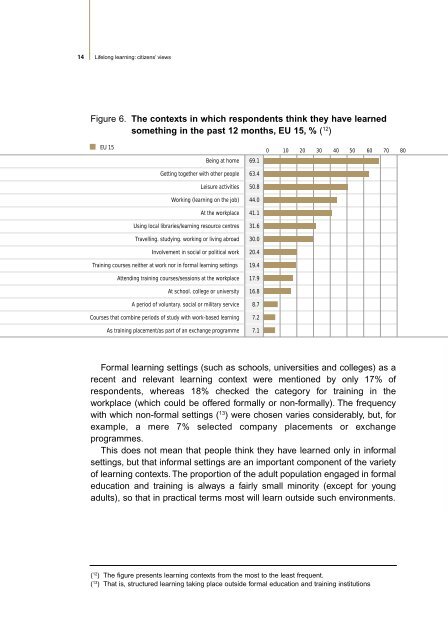Lifelong learning: citizens' views - European Commission - Europa
Lifelong learning: citizens' views - European Commission - Europa
Lifelong learning: citizens' views - European Commission - Europa
Create successful ePaper yourself
Turn your PDF publications into a flip-book with our unique Google optimized e-Paper software.
14<strong>Lifelong</strong> <strong>learning</strong>: citizens’ <strong>views</strong>Figure 6. The contexts in which respondents think they have learnedsomething in the past 12 months, EU 15, % ( 12 )EU 15Being at home 69.1Getting together with other people 63.4Leisure activities 50.8Working (<strong>learning</strong> on the job) 44.0At the workplace 41.1Using local libraries/<strong>learning</strong> resource centres 31.6Travelling. studying. working or living abroad 30.0Involvement in social or political work 20.40 10 20 30 40 50 60 70 80Training courses neither at work nor in formal <strong>learning</strong> settings 19.4Attending training courses/sessions at the workplace 17.9At school. college or university 16.8A period of voluntary. social or military service 8.7Courses that combine periods of study with work-based <strong>learning</strong> 7.2As training placement/as part of an exchange programme 7.1Formal <strong>learning</strong> settings (such as schools, universities and colleges) as arecent and relevant <strong>learning</strong> context were mentioned by only 17% ofrespondents, whereas 18% checked the category for training in theworkplace (which could be offered formally or non-formally). The frequencywith which non-formal settings ( 13 ) were chosen varies considerably, but, forexample, a mere 7% selected company placements or exchangeprogrammes.This does not mean that people think they have learned only in informalsettings, but that informal settings are an important component of the varietyof <strong>learning</strong> contexts. The proportion of the adult population engaged in formaleducation and training is always a fairly small minority (except for youngadults), so that in practical terms most will learn outside such environments.( 12 ) The figure presents <strong>learning</strong> contexts from the most to the least frequent.( 13 ) That is, structured <strong>learning</strong> taking place outside formal education and training institutions
















